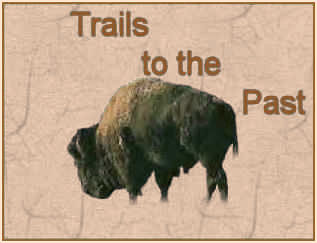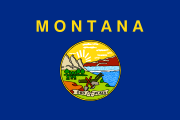Various indigenous peoples lived in the territory of the present-day state of Montana for thousands of years. Historic tribes encountered by Europeans and settlers from the United States included the Crow in the south-central area; the Cheyenne in the southeast; the Blackfeet, Assiniboine and Gros Ventres in the central and north-central area; and the Kootenai and Salish in the west. The smaller Pend d' Oreille and Kalispel tribes lived near Flathead Lake and the western mountains, respectively.
The land in Montana east of the continental divide was part of the Louisiana Purchase in 1803. Subsequent to and particularly in the decades following the Lewis and Clark Expedition, American, British and French traders operated a fur trade, typically working with indigenous peoples, in both eastern and western portions of what would become Montana. These dealings were not always peaceful, and though the fur trade brought some material gain for indigenous tribal groups it also brought exposure to European diseases and altered their economic and cultural traditions. Until the Oregon Treaty (1846), land west of the continental divide was disputed between the British and U.S. and was known as the Oregon Country. The first permanent settlement by Euro-Americans in what today is Montana was St. Mary's (1841) near present day Stevensville. In 1847, Fort Benton was established as the uppermost fur-trading post on the Missouri River. In the 1850s, settlers began moving into the Beaverhead and Big Hole valleys from the Oregon Trail and into the Clark's Fork valley.
The first gold discovered in Montana was at Gold Creek near present day Garrison in 1852. A series of major mining discoveries in the western third of the state starting in 1862 found gold, silver, copper, lead, coal (and later oil) that attracted tens of thousands of miners to the area. The richest of all gold placer diggings was discovered at Alder Gulch, where the town of Virginia City was established. Other rich placer deposits were found at Last Chance Gulch, where the city of Helena now stands, Confederate Gulch, Silver Bow, Emigrant Gulch, and Cooke City. Gold output from 1862 through 1876 reached $144 million; silver then became even more important. The largest mining operations were in the city of Butte, which had important silver deposits and gigantic copper deposits.
Montana Territory
Prior to the creation of Montana Territory (1864–1889), various parts of what is now Montana were parts of Oregon Territory (1848–1859), Washington Territory (1853–1863),Idaho Territory (1863–1864), and Dakota Territory (1861–1864). Montana became a United States territory (Montana Territory) on May 26, 1864. The first territorial capital was at Bannack. The first territorial governor was Sidney Edgerton. The capital moved to Virginia City in 1865 and to Helena in 1875. In 1870, the non-Indian population of Montana Territory was 20,595. The Montana Historical Society, founded on February 2, 1865, in Virginia City is the oldest such institution west of the Mississippi (excluding Louisiana). In 1869 and 1870 respectively, the Cook–Folsom–Peterson and the Washburn–Langford–Doane Expeditions were launched from Helena into the Upper Yellowstone region and directly led to the creation of Yellowstone National Park in 1872.
Conflicts
As white settlers began populating Montana from the 1850s through the 1870s, disputes with Native Americans ensued, primarily over land ownership and control. In 1855, Washington Territorial Governor Isaac Stevens negotiated the Hellgate treaty between the United States Government and the Salish, Pend d' Oreille, and the Kootenai people of western Montana, which established boundaries for the tribal nations. The treaty was ratified in 1859. While the treaty established what later became the Flathead Indian Reservation, trouble with interpreters and confusion over the terms of the treaty led whites to believe that the Bitterroot Valley was opened to settlement, but the tribal nations disputed those provisions. The Salish remained in the Bitterroot Valley until 1891.
The first U.S. Army post established in Montana was Camp Cooke on the Missouri River in 1866 to protect steamboat traffic going to Fort Benton, Montana. More than a dozen additional military outposts were established in the state. Pressure over land ownership and control increased due to discoveries of gold in various parts of Montana and surrounding states. Major battles occurred in Montana during Red Cloud's War, the Great Sioux War of 1876, the Nez Perce War and in conflicts with Piegan Blackfeet. The most notable of these were the Marias Massacre (1870), Battle of the Little Bighorn (1876), Battle of the Big Hole(1877) and Battle of Bear Paw (1877). The last recorded conflict in Montana between the U.S. Army and Native Americans occurred in 1887 during the Battle of Crow Agency in the Big Horn country. Indian survivors who had signed treaties were generally required to move onto reservations.
Chief Joseph and Col. John Gibbon met again on the Big Hole Battlefield site in 1889Simultaneously with these conflicts, bison, a keystone species and the primary protein source that Native people had survived on for centuries were being destroyed. Some estimates say there were over 13 million bison in Montana in 1870. In 1875, General Philip Sheridan pleaded to a joint session of Congress to authorize the slaughtering of herds in order to deprive the Indians of their source of food. By 1884, commercial hunting had brought bison to the verge of extinction; only about 325 bison remained in the entire United States.
Cattle Ranching
Cattle ranching has been central to Montana's history and economy since Johnny Grant began wintering cattle in the Deer Lodge Valley in the 1850s and traded cattle fattened in fertile Montana valleys with emigrants on the Oregon Trail. Nelson Story brought the first Texas Longhorn cattle into the territory in 1866. Granville Stuart, Samuel Hauser and Andrew J. Davis started a major open range cattle operation in Fergus County in 1879. The Grant-Kohrs Ranch National Historic Site in Deer Lodge is maintained today as a link to the ranching style of the late 19th century. Operated by the National Park Service, it is a 1,900-acre (7.7 km2) working ranch.
Railroads
Tracks of the Northern Pacific Railroad (NPR) reached Montana from the west in 1881 and from the east in 1882. However, the railroad played a major role in sparking tensions with Native American tribes in the 1870s. Jay Cooke, the NPR president launched major surveys into the Yellowstone valley in 1871, 1872 and 1873 which were challenged forcefully by the Sioux under chief Sitting Bull. These clashes, in part, contributed to the Panic of 1873 which delayed construction of the railroad into Montana. Surveys in 1874, 1875 and 1876 helped spark the Great Sioux War of 1876. The transcontinental NPR was completed on September 8, 1883, at Gold Creek.
Tracks of the Great Northern Railroad (GNR) reached eastern Montana in 1887 and when they reached the northern Rocky Mountains in 1890, the GNR became a significant promoter of tourism to Glacier National Park region. The transcontinental GNR was completed on January 6, 1893, at Scenic, Washington.
In 1881, the Utah and Northern Railway a branch
line of the Union Pacific completed an arrow gauge line from
northern Utah to Butte. A number of smaller spur lines operated in
Montana from 1881 into the 20th century including the Oregon Short
Line, Montana Railroad and Milwaukee Road.
Statehood
Buffalo Soldiers, Ft. Keogh, Montana, 1890. The
nickname was given to the "Black Cavalry" by the Native American
tribes they fought. Under Territorial Governor Thomas Meagher,
Montanans held a constitutional convention in 1866 in a failed bid
for statehood. A second constitutional convention was held in Helena
in 1884 that produced a constitution ratified 3:1 by Montana
citizens in November 1884. For political reasons, Congress did not
approve Montana statehood until 1889. Congress approved Montana
statehood in February 1889 and President Grover Cleveland signed an
omnibus bill granting statehood to Montana, North Dakota, South
Dakota and Washington once the appropriate state constitutions were
crafted. In July 1889, Montanans convened their third constitutional
convention and produced a constitution acceptable by the people and
the federal government. On November 8, 1889 President Benjamin
Harrison proclaimed Montana the forty-first state in the union. The
first state governor was Joseph K. Toole. In the 1880s, Helena (the
current state capital) had more millionaires per capita than any
other United States city.

